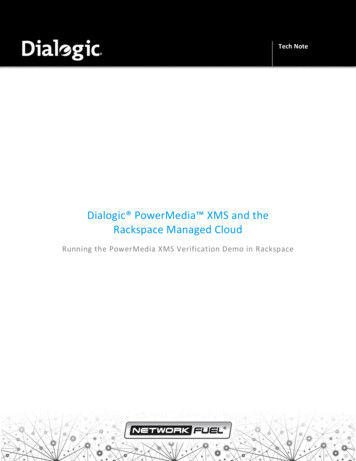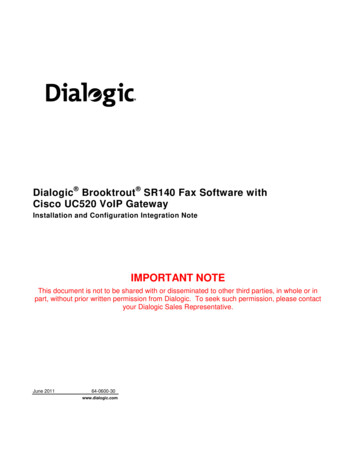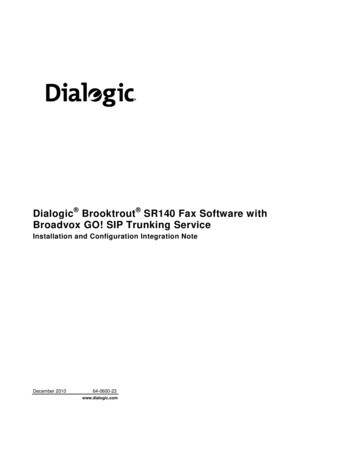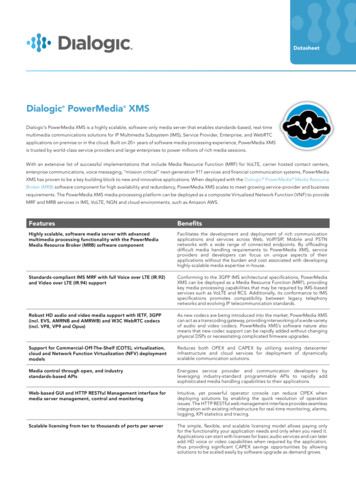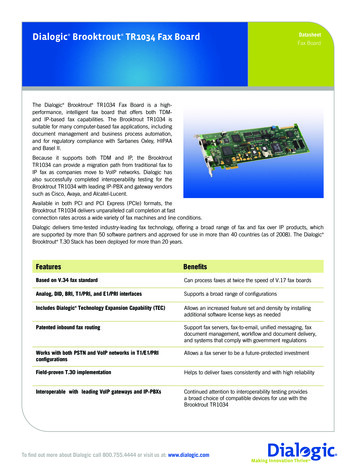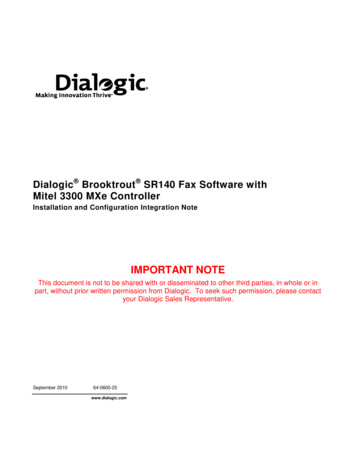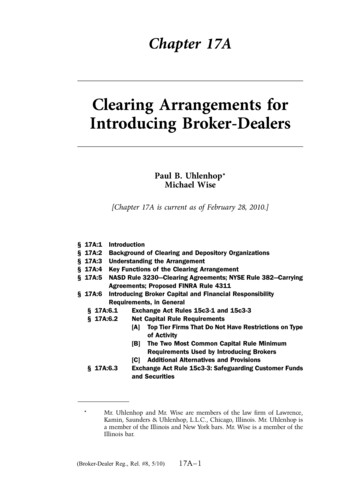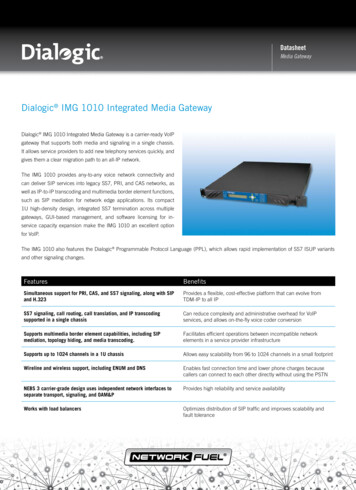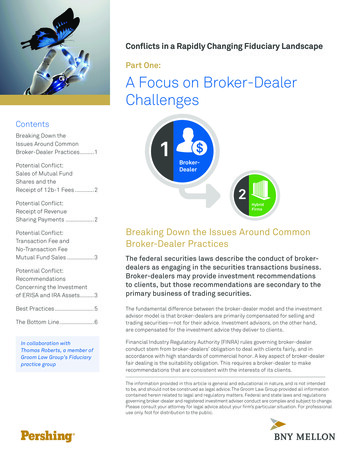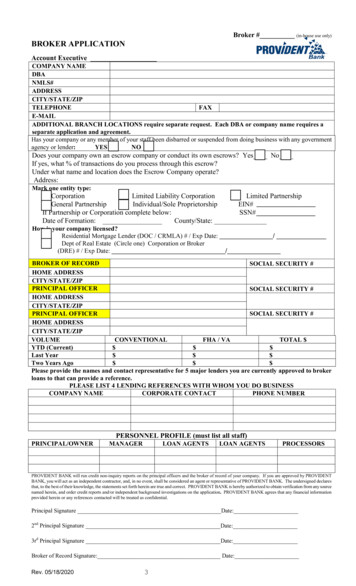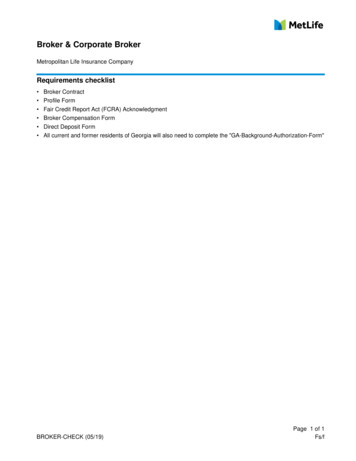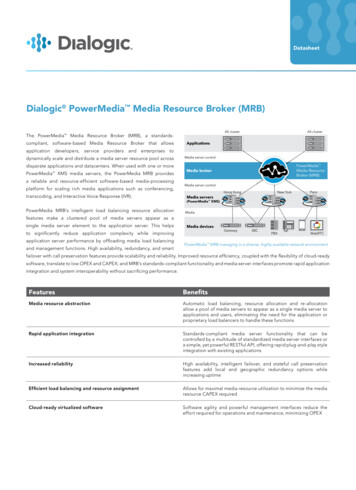
Transcription
DatasheetDialogic PowerMedia Media Resource Broker (MRB)AS clusterThe PowerMedia Media Resource Broker (MRB), a standardscompliant, software-based Media Resource Broker that erprisesdisparate applications and datacenters. When used with one or morePowerMediaApplicationstodynamically scale and distribute a media server resource pool across AS clusterXMS media servers, the PowerMedia MRB providesa reliable and resource-efficient software-based media-processingplatform for scaling rich media applications such as conferencing,transcoding, and Interactive Voice Response (IVR).Media server controlPowerMedia Media ResourceBroker (MRB)Media brokerMedia server controlHong KongNew YorkParisMedia servers(PowerMedia XMS) PowerMedia MRB’s intelligent load balancing resource allocationMediafeatures make a clustered pool of media servers appear as asingle media server element to the application server. This helpsMedia devicesto significantly reduce application complexity while improvingapplication server performance by offloading media load balancingand management functions. High availability, redundancy, and smartGatewaySBCPBXWebRTCPowerMedia MRB managing in a diverse, highly available network environmentfailover with call preservation features provide scalability and reliability. Improved resource efficiency, coupled with the flexibility of cloud-readysoftware, translate to low OPEX and CAPEX; and MRB’s standards-compliant functionality and media server interfaces promote rapid applicationintegration and system interoperability without sacrificing performance.FeaturesBenefitsMedia resource abstractionAutomatic load balancing, resource allocation and re-allocationallow a pool of media servers to appear as a single media server toapplications and users, eliminating the need for the application orproprietary load balancers to handle these functionsRapid application integrationStandards-compliant media server functionality that can becontrolled by a multitude of standardized media server interfaces ora simple, yet powerful RESTful API, offering rapid plug-and-play styleintegration with existing applicationsIncreased reliabilityHigh availability, intelligent failover, and stateful call preservationfeatures add local and geographic redundancy options whileincreasing uptimeEfficient load balancing and resource assignmentAllows for maximal media resource utilization to minimize the mediaresource CAPEX requiredCloud-ready virtualized softwareSoftware agility and powerful management interfaces reduce theeffort required for operations and maintenance, minimizing OPEX
Dialogic PowerMedia Media Resource Broker (MRB)DatasheetStandardized Media Resource Broker (MRB) FunctionalityMedia Resource Brokers (MRBs), including the PowerMedia MRB, are standardized network elements that manage media resource availabilityand reliability, providing improved utilization and reliability of deployed media resources in the network.As defined in MRB specifications, these elements perform one or more critical media resource management functions, including: Balancing requests from multiple application servers or app server clustersEfficient utilization and allocation of the MRF/Media Server (MS) resource poolsProviding a monitoring mechanism for media server status and capabilitiesSupporting media control payloads such as MSML and VXMLMRBs are formally defined by the IETF in RFC 6917 – Media Resource Brokering. The MRB has also been incorporated in the 3GPP TS 23.218IP Multimedia System (IMS) architecture as the functional entity responsible for query and management of the Media Resource Function(MRF) in the IMS network.PowerMedia MRB BenefitsIn addition to meeting the functional requirements as specified in the MRB standards referenced above, PowerMedia MRB provides manyadditional capabilities, including: Stateful call preservationIntelligent resource controlMRB high availabilityLocal and geographic redundancyBroad range of standard media server interfacesManagement interfacesSoftware flexibilityStateful call preservation for seamless reliabilityStateful call preservation importantly minimizes the impact of a media server failover in conferencing applications. PowerMedia MRB providesstateful call preservation so that if a PowerMedia XMS instance should lose power or connectivity, another PowerMedia XMS can quickly take itsplace with minimal impact to callers.PowerMedia MRB continually monitors media control state and call script status of all transactions. When the MRB detects a media serveroutage, it immediately locates another media server and uses the stored state information to reestablish the sessions on a new media serverand reconnect all clients within seconds or less. This allows the call to automatically continue without requiring action by or from the applicationserver or users.Intelligent resource control for resource efficiencyPowerMedia MRB also includes mechanism to monitor the health and load of all PowerMedia XMS media servers in a MRB cluster. This allows theMRB to intelligently load balance traffic to the appropriate media server to pre-emptively avoid overload situations.PowerMedia MRB is call state aware of all the PowerMedia XMS media servers in its cluster. Leveraging this intelligence, it keeps all users ina conference on the same media server and can cascade them across the least loaded media servers in the cluster if the party size starts toreach the limits of original media server’s capacity. This happens completely transparently to the application server, eliminating the need fordevelopment of this complex coordination.2
Dialogic PowerMedia Media Resource Broker (MRB)DatasheetHigh availability configuration for carrier-class reliabilityThe PowerMedia MRB can be deployed in either standalone or active/standby redundant configuration. In the redundant configuration, thePowerMedia MRB actively checkpoints and replicates call state and session information, providing for no service disruption in case of device orpower failure.Local and geographic redundancy for peak uptimeMRB-controlled media server clustering provides redundancy in case of any individual media server outage. In addition, media servers in an MRBcluster can be geographically distributed. The MRB can distribute load across distinct geographic locations, helping to avoid large-scale outageswere an entire datacenter to fail. The PowerMedia MRB can also perform disaster recovery functions, moving calls from one datacenter to another.Standards-compliant for beneficial interoperabilityDialogic’s PowerMedia MRB is compliant with in-line unaware MRB as described in IETF RFC 6917. In-line unaware mode makes the media servercluster appear like a media server to the application server. This means no load balancing capabilities need to be implemented at the applicationserver. PowerMedia MRB performs all critical specified MRB functions, and much more, including: Inbound load balancing requests from one or many distinct application serversOutbound load balancing across many media serversMonitoring the status of all media servers in a clusterSupporting common media control payloads and signaling schemes, including MSML, VXML, and NETANNPowerMedia MRB also works in IMS environments to control a pool of Media Resource Function (MRF) resources, as outlined in 3GPP TS 23.218.Comprehensive media server control interfaces for rapid integrationThe PowerMedia MRB supports a wide variety of both traditional telephony and web oriented media control interfaces. The PowerMedia MRBand PowerMedia XMS media servers can be rapidly integrated into networks with minimal effort - often with little or no modification on theApplication Server.Supported media control interfaces include: Media Server Markup Language (MSML)Voice eXtensible Markup Language (VXML)RFC 4240 - Basic Network Media Services with SIP (NETANN)Java Specification Media Server Control API (JSR 309)Web-based Representational State Transfer (RESTful) APIThe SIP, MSML, VXML, and JSR 309 interfaces are all standards-compliant, meaning they interface seamlessly with application servers that alreadyuse these interfaces.For developers who want more control or to leverage web-oriented mechanisms, Dialogic’s PowerMedia XMS RESTful interface has beendesigned to be fully functional with a minimal learning curve and broad use in nearly any development environment.Powerful and easy-to-use built in cluster management systemThe PowerMedia MRB management offers a web UI to greatly simplify operational tasks associated with configuration and maintenance activities.The MRB’s web UI modules manage different aspects of the MRB. Available WebUI management modules include: Real-time Service DashboardMRB Configuration, Management, Alarm and ReportingMedia Server Configuration, Management and Call StatisticsUser AdministrationLogging and Tracing Capabilities3
Dialogic PowerMedia Media Resource Broker (MRB)DatasheetSoftware-based for maximum flexibilityLike the PowerMedia XMS media server, PowerMedia MRB is 100% software-based and works with popular hypervisors. An entire MRB clustercan be quickly redeployed to another datacenter or scaled up or down as needed within a datacenter without the operational burden of dealingwith specialized physical equipment.PowerMedia MRB is also cloud-ready and suitable for Network Function Virtualization (NFV) environments.Example Use CaseMedia server clustering for large scale transcoding, conferencing, IVR and other applicationsFigure 2 illustrates an example of an audio conferencing solution with PowerMedia MRB and PowerMedia XMS for business or social interaction.Users can call into the conferencing solution from any SIP endpoint, softphone, or WebRTC compatible browser or app. In this example,PowerMedia MRB load balances the App Server’s audio conference resource request across available media server resources in the cluster tohandle high loads.PowerMedia MRBConference application serverMSMLDesktop UC clientWebRTCSIP phoneHD voiceSmartphoneMedia server clusterFigure 2 - High-scale audio conference example using a variety of SIP and WebRTC endpointsOther use casesOther common MRB use case examples include: Media server high availability and call preservation Geographic Redundancy and Disaster Recovery Network expansion including “cap and grow” deployment strategyTechnical SpecificationsStandardsIETF RFC 69173GPP TS 23.218GSMA IR.92, IR.94Control interfacesMedia control:MSML (SIP), REST, JSR 309 (MSML), VXML, NETANN4Tablet
Dialogic PowerMedia Media Resource Broker (MRB)DatasheetSecurity FeaturesTLSInbound overload controlMedia pinhole managementAdmission ControlLicense controlCodec-based routingTraffic Distribution AlgorithmsRound RobinMedia Server Availability (Real time-monitoring)Least loadedLocation awareQoS and StatisticsReal time call statistics for each managed Media Server:Identity and location, CPU & memory utilization, Audio and video codec support & licensing,Number of signaling & media sessionsScalabilityMaximum Call Attempts Capacity:500 sessions per secondMaximum INVITE sessions:50,000ManagementIntegrated web-based management (https) and real-time dashboard and analyticsSNMP based-AlarmsHistorical and real-time statistics and reportsMedia Server Configuration and ManagementRole-based User ManagementRedundancy1 1 (active/standby) MRB RedundancyLossless call preservation for conference and joined callsLocal and Geographic Media Server redundancyVirtualization SupportVMware ESXi 5.xOracle VMHardware Support and Minimum System RequirementsHardware:Intel Architecture-based serverOperating System (64-bit OS):Dependency:CentOS Release 6.4 and 7.0; RedHat Enterprise Linux Release 6.4 and 7.0Java Runtime Environment (JRE) 1.8 or higherProcessor:Intel Dual 56xx or greaterEthernet:Single or Dual 1000Base-TX (RJ-45)Memory:12 GB RAM minimumStorage:60 GB HD minimumNetwork Interfaces (Recommended) Signaling and Media - 2x1 Gigabit Ethernet (10/100/1000 Base-T), Management - 1x Gigabit Ethernet(10/100/1000 Base-T), High Availability - 1x Gigabit Ethernet (1000 Base-T)For More InformationFor more information about the product discussed in this datasheet, contact your local Dialogic representative. Worldwide contact informationis available online at www.dialogic.com/contact.5
www.dialogic.comFor a list of Dialogic locations and offices, please visit: https://www.dialogic.com/contact.aspxDialogic and PowerMedia are either registered trademarks or trademarks of Dialogic Inc. and its affiliates or subsidiaries (“Dialogic”). Dialogic’s trademarks may be used publicly only withpermission from Dialogic. Such permission may only be granted by Dialogic’s legal department at 6700 de la Cote-de-Liesse Road, Suite 100, Borough of Saint-Laurent, Montreal, Quebec,Canada H4T 2B5. The names of actual companies and products mentioned herein are the trademarks of their respective owners.Dialogic encourages all users of its products to procure all necessary intellectual property licenses required to implement their concepts or applications, which licenses may vary from countryto country. None of the information provided in this Datasheet other than what is listed under the section entitled Technical Specifications forms part of the specifications of the product andany benefits specified are not guaranteed. No licenses or warranties of any kind are provided under this datasheet.Dialogic may make changes to specifications, product descriptions, and plans at any time, without notice.Any use case(s) shown and/or described herein represent one or more examples of the various ways, scenarios or environments in which Dialogic products can be used. Such use case(s) arenon-limiting and do not represent recommendations of Dialogic as to whether or how to use Dialogic products.This document discusses one or more open source products, systems and/or releases. Dialogic is not responsible for your decision to use open source in connection with Dialogic products(including without limitation those referred to herein), nor is Dialogic responsible for any present or future effects such usage might have, including without limitation effects on your products,your business, or your intellectual property rights.This document pertains to a planned future release of a Dialogic product. Dialogic may make changes to specifications, product descriptions, and plans as well as to related documentation,at any time, without notice both in general and with respect to this product.Copyright 2016 Dialogic Inc. All rights reserved.02/1614160-02
Gateway SBC PBXW ebRTC . Supporting media control payloads such as MSML and VXML MRBs are formally defined by the IETF in RFC 6917 - Media Resource Brokering . The MRB has also been incorporated in the 3GPP TS 23.218 IP Multimedia System (IMS) architecture as the functional entity responsible for query and management of the Media .
